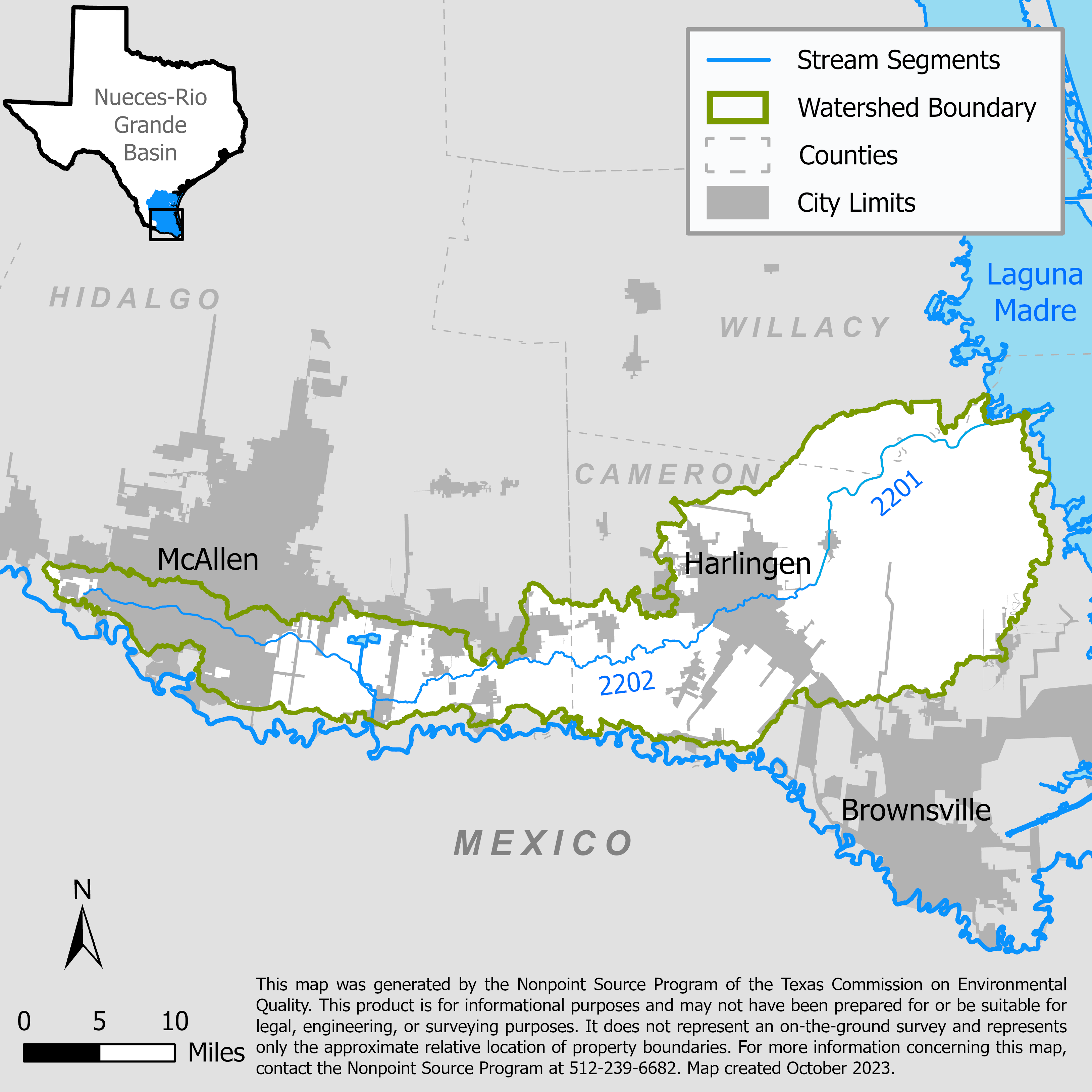Arroyo Colorado Watershed Protection Plan Implementation
A multitude of grant-supported projects implementing the Arroyo Colorado Watershed Protection Plan (WPP) throughout the Lower Rio Grande Valley (LRGV). Projects involve low impact development (LID), water quality monitoring, and septic system remediation.

On this page:
Project Area
River Basin: Nueces-Rio Grande
Water Body: Arroyo Colorado (2201 and 2202)
Location: Hidalgo, Cameron, and Willacy counties
Background
The Arroyo Colorado flows through Hidalgo, Cameron, and Willacy counties in the LRGV and into the Laguna Madre. The Arroyo Colorado includes a tidally influenced marine segment (2201), which does not meet state water quality standards because dissolved oxygen (DO) levels exceed the criteria used to evaluate attainment of the aquatic-life use. This is also the case with the freshwater segment (2202). Neither segment meets the state standards for primary contact recreation use due to elevated bacteria concentrations.
To address water quality issues, the Arroyo Colorado Watershed Partnership (Partnership) developed the Arroyo Colorado WPP, which was accepted by the U. S. Environmental Protection Agency (EPA) in 2007 and was updated in 2017. The WPP identifies LID and septic system management as key management measures for reducing pollutants entering the waterways.
Project Descriptions
Watershed Partnership Support and WPP Implementation Coordination
April 2007 – August 2011
September 2011 – August 2014
March 2016 – February 2020
Through these three consecutive projects, the Texas Water Resources Institute (TWRI) used grant funds to hire and pay a watershed coordinator for the Arroyo Colorado watershed who was responsible for directing implementation of the Arroyo Colorado WPP. The main functions of the watershed coordinator were to facilitate stakeholder meetings and conduct education and outreach activities, as well as other activities designed to promote private and public support. In the final project, a septic system database was also developed.
Water Quality Monitoring and WPP Update
October 2012 – June 2017
September 2013 – November 2017
In two concurrent projects, TWRI completed new water quality modeling and used the results to update the Arroyo Colorado WPP. The Soil and Water Assessment Tool (SWAT) was used to model nutrient, sediment, and other pollutants input to the stream. Pollutant loads were fed into an instream model of the Arroyo Colorado tidal segment that was developed to simulate the DO level response to stakeholder proposed watershed management measures. Bacteria loading to both Arroyo Colorado segments was also modeled using SWAT.
The updated Arroyo Colorado WPP was accepted by EPA in 2017.
Low Impact Development
June 2009 – April 2013
Texas A&M University, Kingsville (TAMUK) installed and monitored enhancement features at three regional stormwater detention facilities in the City of McAllen including constructed wetlands, biofilters, and a microscreen filter. These features were designed to function under the intense heat and drought conditions common to the area.
May 2011 – May 2015
August 2011 – June 2015
August 2012 – June 2017
In a multiphase approach, TAMUK partnered with various cities to install high-visibility LID practices throughout the LRGV and the Arroyo Colorado watershed. TAMUK and local partners also conducted water quality monitoring to evaluate the effectiveness of installed LID, the results of which were incorporated into a regional technical guidance manual to facilitate and encourage more LID projects. An intensive education and outreach campaign was conducted in which tours and activities were led to educate stakeholders about the advantages of LID.
In addition, TAMUK evaluated city codes to determine potential modifications to make it easier to incorporate LID practices in new development and created an inventory database of LID and other best management practices (BMPs) in the watershed.
December 2016 – August 2020
TWRI and the City of Los Fresnos installed a bioswale to treat stormwater runoff and a rainwater harvesting system at a new 20-acre nature park. Students volunteered in planting native plants for these LID installations. TWRI, Texas Stream Team, and Los Fresnos Independent School District (ISD) monitored the effectiveness of a bioswale and wetland at Los Fresnos High School in treating runoff from the parking lot.
September 2018 – August 2022
TAMUK monitored the effectiveness of different filtering media applications in bioswales and bioretention systems for widespread adoption in the watershed. These data informed a cost-benefit analyses, which can be used to bolster local ordinances and integrate LID planning. TAMUK also provided training on LID operation and maintenance, conducted a delineation in the northern watershed boundary, developed the Arroyo Colorado watershed portion of a cyber-infrastructure database, and conducted a study to identify optimal locations for implementing BMPs.
Septic System Remediation
October 2018 – February 2022
TWRI produced a septic system inventory for Hidalgo and Cameron counties, which was added to the septic system database created in an earlier project. The database has helped to identify areas that have a high probability of septic system failure, and will be used to coordinate with wastewater treatment facility operators to plan for future inclusion of septic systems and colonia infrastructure. In addition, TWRI performed septic system inspections and pump outs.
TWRI also developed education and outreach materials and hosted workshops on watershed and septic system management, specifically targeting homeowners, to encourage continued stakeholder involvement, which will ensure continued successful implementation of the Arroyo Colorado WPP.
September 2022 – August 2025
TWRI will expand the septic system database to include the inland portion of the watershed. Newly obtained information and maps will also be added to further enhance septic system management.
Stormwater management and education that was piloted at Los Fresnos ISD will be refined and replicated at the new Rio Hondo Middle School. Grey stormwater features will be converted into green infrastructure by retrofitting bioswales and detention basins with native coastal/riparian vegetation. In addition, the watershed coordinator will continue to facilitate education, outreach, and the Partnership to ensure long-term sustainability of WPP implementation efforts.
For More Information
Arroyo Colorado Watershed Partnership webpage .
To find out more about the NPS Program, call 512-239-6682 or email us at nps@tceq.texas.gov.

 Back to top
Back to top